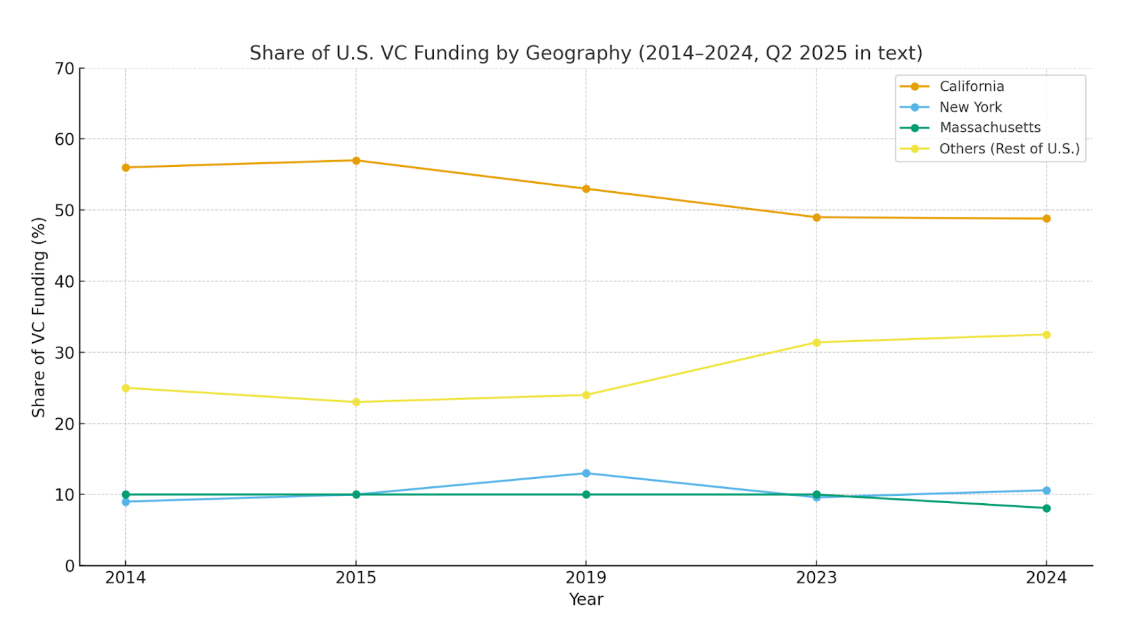When exploring what investors are looking for, you’ll focus on why geographical location is crucial for VCs in startup evaluation. Typically, when they look for investment opportunities, their primary criteria are an assurance of high returns at minimal risk.
As your expert fundraising consultant will advise, several other factors are under consideration. For instance, the company’s growth stage, concept, team, business plan, intellectual property (IP), and sector. Investors also focus on the founder’s experience and track record with other startups.
Interestingly, the geographical location where the company will conduct operations is also high on their list of priorities. Many entrepreneurs tend to overlook this key factor, but you should include this criterion. Add it to your checkboxes when compiling a list of investors to approach.
Statistics indicate that in 2024, investors diverted at least 48.8% of capital to companies based in California. 10.6% of the funds flowed to startups in New York, and 8.1% to those in Massachusetts. The remaining 32.6% went to backing companies based outside of these three states.
Surprising? Venture capital firms base their choice of companies in their investment portfolio on their internal agenda. Some prefer to invest in overseas companies, while others pick those within the country’s borders. Others select startups they can reach with a short plane ride.
Read ahead to understand how geographical location is crucial for VCs in startup evaluation. And how to leverage this aspect to target investors.

*FREE DOWNLOAD*
The Ultimate Guide To Pitch Decks
Investors Select Accessible Locations So They Can Provide Mentoring
Investors today are much more than simply sources of capital. They select projects and concepts with the intention of nurturing them to build the next unicorns. Thus, they may request a board seat as part of the investment terms and conditions.
Investors may also require voting rights and other privileges depending on the level of involvement and influence they’ll exercise. You can expect them to offer additional resources to steer the company toward exceptional growth and profitability.
Accordingly, investors select seed-stage startups located close to their fund’s office. This strategy ensures proximity so they can have frequent interactions with the founders and their teams. Investing in local companies enables them to attend board meetings in person and build relationships.
The investors’ representative to the board can provide one-on-one mentoring along with easy access to networking opportunities. You can rely on them for introductions to other founders and businesses within your supply and distribution chains.
When you’re ready to expand your team, the investor can make recommendations for top talent available in the industry. Lower travel expenses for participating in meetings and other company events are yet another advantage.

Raise Capital Smarter, Not Harder
- AI Investor Matching: Get instantly connected with the right investors
- Pitch & Financial Model Tools: Sharpen your story with battle-tested frameworks
- Proven Results: Founders are closing 3× faster using StartupFundraising.com
Investors Focus on Sector-Specific Geographical Locations
Geographical location is crucial for VCs in startup evaluation since several cities are veritable hubs for specific sectors. For instance, computer chip manufacturers tend to congregate in Silicon Valley.
Similarly, Napa Valley is known for its wine production, just as the auto industry is concentrated in Detroit. Other examples include the movie production industry of Hollywood and the coffee industry of Seattle. Then again, Wall Street is synonymous with New York.
Companies have higher chances of success if they are located in and around centers of excellence in their industries. These regions foster a culture of innovation and healthy competition, which makes it easier to attract and retain skilled talent.
Investors understand these advantages, which is why they choose to partner with companies that have hubs close by. If you check historical numbers from 2019 through 2024, investment in California has remained the highest, with a temporary dip in 2023.
Sources suggest that investor interest has been concentrated on California in the first two quarters of 2025. The state has attracted an incredible 68% of the dry powder available with investors. On the other hand, investment in Massachusetts and New York has remained steady all through.
Several reasons contribute to this phenomenon. When several startups within a similar sector work within an ecosystem, they build an infrastructure and data centers. These resources serve to support the ecosystem by enabling the sharing of knowledge and expertise.
As a result, the startups work together, creating clusters that act as a magnet for budding founders. They arrive on the scene to leverage the available infrastructure and eventually end up adding to the ecosystem with innovations.
The entire ecosystem receives a boost while also ensuring viable returns for investors. Check out the chart below for a more straightforward overview of how they react.

Investors Balance Growth Stage and Location
Your company’s growth stage could influence investor preference vis-à-vis geographical location. For instance, a fledgling, seed-stage startup needs more hands-on guidance and mentoring as compared to a well-established company.
Accordingly, when it comes to backing later-stage companies, their location might not be high on the investors’ list of priorities. But if they are evaluating a smaller company, they would prefer it to be located close by.
Keep in mind that storytelling is everything in fundraising. In this regard, for a winning pitch deck to help you here, take a look at the template created by Peter Thiel, Silicon Valley legend (see it here), that I recently covered. Thiel was the first angel investor in Facebook with a $500K check that turned into more than $1 billion in cash.
Remember to unlock the pitch deck template that founders worldwide are using to raise millions below.
Investors Nurture Local Communities with Capital
Geographical location is crucial for VCs in startup evaluation since their funds are keenly interested in nurturing local communities. Venture capitalist firms prefer to support startups within the local economy to create jobs and attract talent.
In this way, investors play a crucial role in promoting communities that have the potential for rapid growth. Some of the sectors poised for accelerated growth in 2025 in the US include artificial intelligence (AI), machine learning (ML), e-commerce, and online retail services.
Other industries are attracting investor attention, such as renewable energy, robotics, automation, financial technology (FinTech), healthcare, online edtech, and telemedicine. To nurture these sectors and communities, investors are even known to relax some of their stringent evaluation criteria.
A great example is AI-native startup ecosystems that can bring long-term prosperity to the regions where they are developing.
Investors Target Locations with a Favorable Regulatory Environment
A favorable regulatory environment promotes local businesses and attracts companies that are open to establishing a presence there. Entrepreneurs want to leverage the benefits that regulations offer to ensure accelerated growth in specific regions.
Some favorable local regulations include tax incentives, a streamlined business registration process, and laws supporting intellectual property (IP). As a result, these locations attract startups by lowering the barriers to entry and helping reduce the initial operating costs.
Incentives like tax credits for research and development, grants for innovation, and startup visas to attract talent are major draws. Further, labor-friendly laws, financial technology (FinTech) regulations, and data protection policies also attract not just entrepreneurs, but also investors.
On the other hand, if a location has excessively restrictive regulations, it ends up deterring capital inflows. Investors hesitate to sink money into investments, which is why startups may also avoid setting up shop there.
Venture capital firms prioritize regions that support investor activity with clear exit pathways, like rules for Initial Public Offerings (IPOs). Or, policies favoring mergers and acquisitions (M&A). VCs also look for locations that offer investor protection programs and flexible corporate structures.
Thus, a location’s regulatory environment can act as a barrier or catalyst for startup ecosystems.
Let’s try some examples:
- Texas attracts startups since it does not have state income tax and also has business-friendly regulations. The state also offers the Texas Enterprise Fund to attract startups. As a result, entrepreneurs and investors have invested substantial capital in cities like Austin to leverage the favorable legal climate.
- Yet another example is the state of Colorado, which was one of the first to legalize the cannabis industry. The state quickly became the hub for cannabis-centric tech startups taking advantage of incentives to build compliance platforms and supply-chain software.
Geographical location is only one of the many factors to consider when exploring how to put together an investor outreach strategy. If you’re looking for more information, check out this video I have created,
Interestingly, The Reverse is Also True!
Although geographical location is crucial for VCs in startup evaluation, and they prefer to select hubs, sometimes the reverse is also true. Investors may target innovation centers outside traditional spots like New York City and Silicon Valley. They look for new and emerging clusters being formed. Let’s try a few examples.
- As mentioned earlier, the state of Texas has long been a magnet for startups due to its favorable regulatory environment. In recent years, major firms such as Oracle and Tesla have also established facilities here. Companies working in sectors such as electric vehicles, fintech, and enterprise software have followed the lead of larger corporates.
- Yet another example is Miami in Florida, which has quickly emerged as a hub for Web3, fintech, and crypto companies. Florida not only offers favorable tax policies but also provides proactive local government support that attracts startups.
- Corporate giants like Global Payments have chosen to set up base in Atlanta, Georgia. The city is now attracting new entrepreneurs thanks to its robust fintech and payments ecosystem.
- Sectors like life sciences, biotech, and AI-driven health innovation are trending toward Raleigh-Durham, North Carolina. It is often referred to as the “Research Triangle.”
- Entrepreneurs developing disruptive ideas in healthtech, enterprise SaaS, and clean energy are now choosing Denver and Boulder, Colorado. These cities have become the upcoming hubs of such sectors.
These examples demonstrate that investors are diversifying their investment opportunities. They are open to considering upcoming startup ecosystems that are thriving thanks to government incentives. The new clusters utilize benefits like lower operational costs and the availability of skilled talent.
As a result, the deal flow pipeline is trending toward locations other than New York, California, and Massachusetts. You’ll note from the graph above that more capital is being diverted to locations outside of the three major centers.
Navigating Geo-Centric Investment Criteria
Now that you understand why geographical location is a vital criterion for investors, you’ll compile your list of targets accordingly. You’ll also design the pitch deck to appeal to their criteria. Here’s what you need to do:
- Identify venture capital funds and angel investors that operate on a regional mandate. You can find the information on their websites or by researching the projects in which they are actively involved. You’re looking for investors committed to nurturing your geographical location by providing capital and expertise.
- Identify incubators and accelerator programs operating within your geographical location. You’ll also list universities and research institutions within your region, along with corporate giants running initiatives to nurture innovation. Underscore your proximity to these organizations and how they can provide tactical advantages to the local ecosystem.
- Ensure your pitch highlights the tactical advantages you have because of your location. For instance, access to bigger talent pools and an existing sector-friendly infrastructure. You’ll also talk about the specific regulations that favor your product portfolio or distribution strategies.
- VCs like to invest in projects that have backing from state innovation grants such as the Small Business Innovation Research (SBIR) or the Small Business Technology Transfer (SBTT). Local venture programs, for example, the NY State Innovation Venture Capital Fund, also interest investors. If you can demonstrate support from these organizations or that you operate in an economic development zone, that’s a positive.
- Research for overseas investors seeking investment opportunities in emerging business hubs like Salt Lake City, Denver, and Miami.
Your pitch narrative should center around how you’re leveraging the geographical advantage, such as the key benefits of operating here. Additionally, emphasize the traction the company has gained due to these advantages. For example, partnerships with local businesses and a location-driven clientele.
Geographical Location is Crucial for VCs in Startup Evaluation
Geographical location can be a primary criterion when investors assess a project as a viable investment opportunity. Their internal dynamics and fund’s agenda can dictate whether they prefer to invest in established economic hubs. Or in upcoming clusters that are demonstrating potential.
When designing a compelling pitch, you’ll highlight the key advantages your location offers that give the brand a competitive edge. Also, emphasize the favorable regulatory environment and the incentives provided by the state and federal governments to foster growth in the zone.
Don’t forget to mention the grants and state capital funds that have invested in your company. VCs like to invest in companies that have attracted government backing. Also, consider overseas investors who are looking to capitalize on available opportunities in upcoming economic hubs.
The underlying factor is that investors are looking for profitable projects to back, and your company could be one of them.
You may also find our free library of business templates interesting. There, you will find every single template you need to build and scale your business completely, all for free. See it here.





Facebook Comments